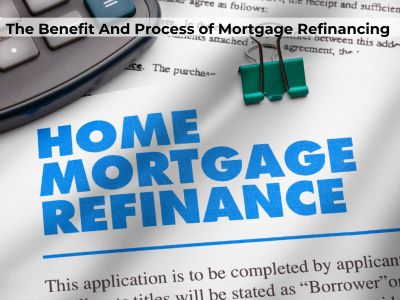You may have heard of mortgage refinancing as a homeowner, but are you aware of what it is and how it works? The process of getting a new mortgage is called mortgage refinancing. Homeowners may gain access to cash for home improvements or other expenses, lower interest rates, and lower monthly payments as a result.
In this blog entry, we’ll investigate the course of home loan renegotiation, the advantages, and what you want to be aware of before pursuing the choice to renegotiate.
What is Mortgage Refinancing?
The process of getting a new loan to replace your current mortgage is referred to as mortgage refinancing. The terms, interest rates, and payment schedules of the new loan may differ from those of your previous mortgage.
Most of the time, homeowners choose to change the terms of their mortgages or take advantage of lower interest rates by refinancing. You can also use refinancing to use your home’s equity to pay for things like home improvements or debt consolidation.
The Advantages of Mortgage Refinancing
There are several advantages to refinancing mortgage in Canada. The most common advantages are:
Lower interest rates
The possibility of getting a lower interest rate than your current mortgage is one of the most significant advantages of refinancing. Lower financing costs can fundamentally diminish your month-to-month contract instalments and set aside your cash over the existence of the advance.
Lower monthly payments
A lower monthly payment can also result from refinancing. You can lower your monthly payments by extending the term of your mortgage, making financial management simpler.
Cash-out refinancing
Homeowners who have built up equity can access it and use it for other expenses with cash-out refinancing. You could, for instance, put the money toward home enhancements, pay for college tuition, or consolidate debt with high-interest rates.
The Mortgage Refinancing Process
There are several steps to the mortgage refinancing process:
Step 1: Determine your goal
It is essential to establish your objectives before beginning the refinancing process. Would you like to reduce your regularly scheduled instalments, decrease your loan cost, or access cash? You can begin looking for a lender who can assist you in achieving your objectives once you have identified them.
Step 2: Check your credit score
When refinancing, the interest rate you will pay is heavily influenced by your credit score. Before beginning the process, check your credit score and take steps to raise it if it is low.
Step 3: Shop Around Lenders
When refinancing, it’s just as important to shop around for the best deal as you were when you got your first mortgage. Compare several lenders’ quotes’ terms, fees, and interest rates.
Step 4: Gather Your Documents
You will need to gather documentation regarding your income, assets, and other financial data to submit an application for a refinance. To speed up the application process, begin gathering this information early on.
Step 5: Apply for the loan
Once you have found a lender with whom you feel at ease, you can apply for the loan. After reviewing your application and verifying your information, the lender will decide whether to approve the loan.
Step 6: Close the advance
Assuming your credit is supported, you’ll have to close the advance, which includes marking the advance archives and paying any charges related to the advance.
Things to Consider Before Mortgage Refinancing:
Costs
Renegotiating can include a few charges and expenses, including application charges, examination charges, and shutting costs. Before deciding to refinance, ensure that you are aware of these expenses.
Interest Rates
Although refinancing can result in lower interest rates, it is essential to remember that not all borrowers are eligible for the best rates. The interest rate you are offered can be affected by your credit score, debt-to-income ratio, and other factors.
Length of loan
A refinancing transaction can also alter the term of your mortgage. While extending the term of your mortgage may result in lower monthly payments, it may also increase interest payments over the loan’s term.
Equity in your home
When you consider a cash-out refinance, remember that you will be using your home’s equity. Although this means you’ll have less equity in your home, it can be an excellent way to pay for home improvements and other costs.
Generally speaking, contract renegotiating can be a great cash-saving tip, bring down your regularly scheduled instalments, or access cash for different costs. However, before deciding to refinance, it is essential to carefully consider your objectives, shop around for the best deal, and comprehend the costs and potential drawbacks.
In conclusion:
Mortgage Refinancing Canada is a cycle that can give property holders a scope of advantages, including lower loan fees, lower regularly scheduled instalments, and admittance to cash for different costs.
But before deciding to refinance, it’s important to know how the process works, think about your goals, and carefully weigh the benefits and drawbacks. By carving out the opportunity to investigate as needs be and find the right bank, you can go with an educated choice that can assist you with setting aside cash and accomplishing your monetary objectives.




